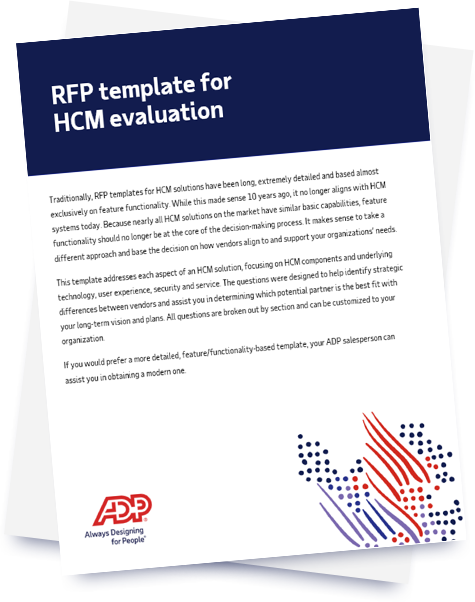With so many human capital management (HCM) solutions offering similar features, today’s HCM RFP templates have to evaluate more than just functionality to be effective. They must also assess if a vendor is a cultural fit for the organization and how well it can support individual business goals. ADP’s HCM RFP template addresses these topics and more to help HR leaders make the most informed decision possible.
Benefits of using an HCM RFP template
An HCM RFP template can help save time and money by improving communication between businesses and HCM providers throughout every step of the evaluation process. Other benefits include:
- Simple, categorized requirements
RFP templates come with a catalog of common HCM features, eliminating the need to create a requirements checklist from scratch. Project leaders can then supplement the baseline information with their own unique needs. - Strategic assessments of available features
HCM RFP templates typically include targeted questions designed to identify how vendors differ in terms of technology, user experience, security and service. - Improved RFP responses from providers
When information is clearly laid out in an RFP template, vendors are more likely to understand if they’re capable of supporting all of the requirements, thereby improving participation and the quality of the responses. - Streamlined HCM implementation
Vendors use RFPs to assess the level of customization necessary and more accurately estimate the cost of development work. Having this information upfront reduces the chances of unexpected project delays or expenses during implementation.
How to use an HCM RFP template
An HCM RFP template provides a solid foundation for evaluating HCM providers, but it still needs business-specific details to elicit valuable responses. HR professionals and project leaders can customize the document by following these general steps:
- Assess existing functionality and shortcomings
Knowing which processes work and where improvements are needed can help guide market research and initial conversations with decision makers. - Gather requirements from key stakeholders
Ask as many team members as possible, from executives to employees, about the features they would like to see in a new HCM system and rank them in terms of priority. - State the business case and objectives
Vendors are more likely to submit relevant responses to an RFP if they understand the business model and how an HCM provider can support long-term goals. Vision and mission statements, plans for expansion and compliance issues, to name a few, may be worth mentioning. - List the process requirements
Explain the functions necessary for HR professionals to perform their daily tasks, such as payroll, time and attendance, and recruitment. - Provide technical requirements
A list of technical capabilities – cloud hosting, mobile accessibility, etc. – lets the HCM provider know the desired means of accessing HR tools. - Ask for vendor information
Requesting additional details about vendors beyond their ability to meet requirements can help narrow viable candidates. Schedules and timing, cost estimates, references and proof of financial stability are all important. - Create evaluation criteria
When the RFPs are returned, use a simple ratings scale to see how capable an HCM provider is of meeting each of the requirements.
What’s included in ADP’s HCM RFP template
ADP’s HCM RFP is designed to highlight the strategic differences between HCM providers so that business leaders can determine which one is the best fit for their organization. It includes a variety of questions, organized by the following topics:
- Strategic direction
- HCM solution overview
- Human resources
- Benefits
- Time and attendance
- Payroll
- Talent acquisition and activation
- Performance management
- Compensation management
- Succession planning
- Learning
- User experience
- Compliance
- Reporting and analytics
- Security
- Implementation
- Service
- Company information
This comprehensive list can be customized to individual business needs and while that might take some effort, depending upon functional requirements, it may save considerable time later when trying to choose between providers.

